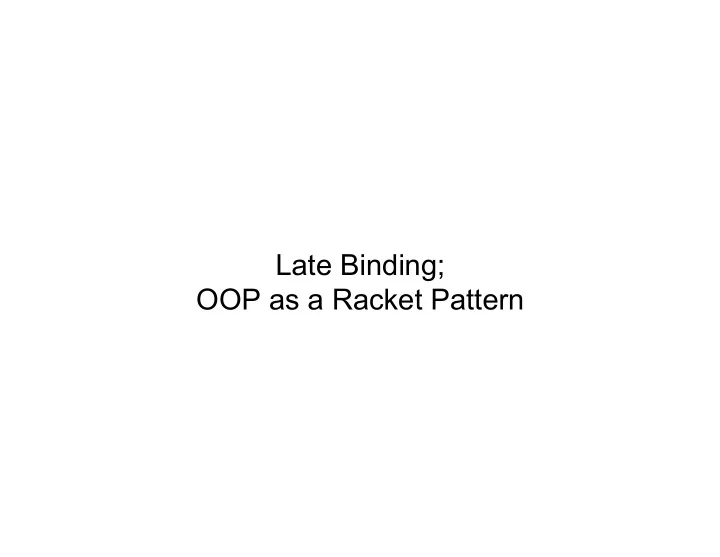

Late Binding; OOP as a Racket Pattern
Today Dynamic dispatch aka late binding aka virtual method calls – Call to self.m2() in method m1 defined in class C can resolve to a method m2 defined in a subclass of C – Most unique characteristic of OOP Need to define the semantics of objects and method lookup as carefully as we defined variable lookup for functional programming Then consider advantages, disadvantages of dynamic dispatch Then encoding OOP / dynamic dispatch with pairs and functions – In Racket – Complement to learning lambdas/closures in C++
Resolving identifiers The rules for "looking up" various symbols in a PL is a key part of the language's definition – So discuss in general before considering dynamic dispatch • Racket: Look up variables in the appropriate environment – Key point of closures' lexical scope is defining "appropriate" • Java: – Lexical scoping like Racket – But also have instance variables, class variables, and methods! • All of these combined with inheritance "break" lexical scope!
class A { int x; int method() { … } } class B extends A { int method() { … } } in some main method somewhere: B b = new B(); b.x = 17; // lookup x … where? // - in current environment -> not found // - in "environment for class B" -> not found // - rule to look in "enclosing environment" // doesn't help here either.
class A { int x; int method() { … } } class B extends A { int method() { … } } in some main method somewhere: A waitWhat; if (Math.random() > .5) waitWhat = new A(); else waitWhat = new B(); whatWhat.method() • Where do we look up method ? • Lexical scoping rules don't help us here, because lexical scoping resolves all variable/function references at compile-time. At compile-time, we don't know what's going to happen .
Takeaway: Looking up the value for a field or the code for a method is different looking up a "regular" variable or "regular" function.
Java method lookup The semantics for method calls e0.m(e1,…,en) 1. Evaluate e0 , e1 , … , en to objects obj0 , obj1 , … , objn – As usual, may involve looking up this , variables, fields, etc. 2. Let C = the class of obj0 (every object has a class) 3. Inside class C , pick "the best m " using the types of e0 , e1 , … , en 4. Evaluate body of method picked: – With formal arguments bound to obj1 , … , objn – With this bound to obj0 -- this implements dynamic dispatch!
Comments on dynamic dispatch • C++ only uses dynamic dispatch on virtual functions. – That's why in that weird example from a few weeks ago we had the "wrong" function being called. • Java always does dynamic dispatch. • More complicated than the rules for closures – Have to treat this specially – May seem simpler only because you learned it first – Complicated doesn't imply superior or inferior • Depends on how you use it … • Overriding does tend to be overused
The OOP trade-off Any method that makes calls to overridable methods can have its behavior changed in subclasses – Maybe on purpose, maybe by mistake • Makes it harder to reason about "the code you're looking at" – Can avoid by disallowing overriding (Java final ) of helper methods you call • Makes it easier for subclasses to specialize behavior without copying code – Provided method in superclass isn't modified later
Manual dynamic dispatch Rest of lecture: Write Racket code with little more than pairs and functions that acts like objects with dynamic dispatch Why do this? – (Racket actually has classes and objects even though not everything is an object) • Demonstrates how one language's semantics is an idiom in another language • Understand dynamic dispatch better by coding it up – Roughly similar to how an interpreter/compiler would do it
Simulating objects in Racket • An object will be a cons cell. – Car = a list of fields (names/value pairs). – Cdr = a list of methods (name/value pairs).
Recommend
More recommend